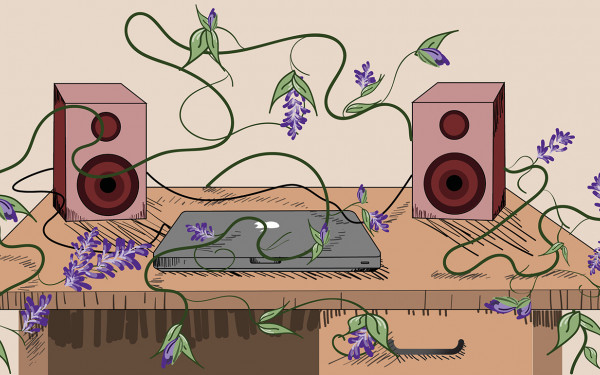Pressing All the Right Keys
A Night with the Concordia Laptop Orchestra
Nobody really knew what to expect when they walked into the classroom where the Concordia Laptop Orchestra was going to perform.
The room was filled with at least thirty laptops—along with a variety of bowls placed on the floor—where students were adding some final touches towards some of the sounds that they created with their computers as well as testing some extra equipment before showtime.
The Concordia Laptop Orchestra—or CLOrk—is made up of students who are majoring in electroacoustics. This group was founded in 2011 by local composer and professor of electroacoustics at Concordia Dr. Eldad Tsabary, who continues to organize and direct the Orchestra.
After waiting for about ten minutes, the lights of the classroom dimmed and various colours began to appear. Tsabary introduces himself and gives a brief explanations about the program for the concert.
A single sound is continuously going to be played in the background while students are expected to improvise by using various sounds, Tsabary explains.
“There is this being in the moment, throughout listening and responding and you do not know where it is going,” he said. Every performance is different and every rehearsal was completely different, Tsabary continued, stating that there is more creativity, listening and overall togetherness.
The use of improvisation is the major key component for CLOrk. It’s what allows individuals to interact with one another without having to face any musical boundaries. George Varoutsos, one of the performers in the orchestra, explained the difference between improvising as a group as opposed to improvising as a solo artist.
“If I am working with myself at home, I need to come up with those other thirty sounds to make a sort of soundscape,” said Varoutsos. Through the collaboration of several students, the orchestra as a whole creates a new soundscape where various sounds are being incorporated into the piece.
The show started with an improvised track that began with the sound of continuous water waves. Without skipping another beat, the students began incorporating different sounds that they created from their laptops or using other pieces of equipment such as small synthesisers, sampling pads and mixers.
Suddenly, a series of unusual sounds reverberates around the room. Towards the middle of the classroom, a woman had stationed herself on the floor—surrounding herself with the bowls in question—and was hitting them. This elicited various sounds in astonishingly perfect synchronization with the students’ sounds that was coming from their laptops.
This concert was highly reminiscent of Pink Floyd’s song “Speak to Me.” Both the song and the piece being performed by Tsabary’s students were based off of improvisation, including various sounds being produced that are perfectly in synch with a given piece.
The first piece seamlessly bled into the second one. Kathy Kennedy—a part-time faculty member of the department of music at Concordia—walks towards the middle of the classroom, grabs the microphone and begins to chant “this song is about freedom of speech.” Kennedy repeats this phrase over and over again, but with a different tone each time. In the background, various rhythmic patterns are being incorporated within the piece.
Listening to the second part of the performance felt like being dropped into a continuous portal where there is no beginning nor end. It was soft and mesmerizing, easy to get ensnared in its rhythmic repetition.
The piece ended with Kennedy saying the exact same words, quietly phasing out of the track while the laptops slowly emitted minimal sounds until there was nothing but silence.
CLOrk ended their performance with one final, looping upbeat jam. Small bowls are continuously being drummed upon, their beat coinciding with the students and their electronically produced sounds.
Donald Trump’s voice suddenly imposes intself into the track, with him constantly repeating the words “China” and “Mexico.” This sudden vocal intrusion gave the audience a chance to laugh—Trump’s looping voice surprisingly in synch with the music and the interchanging colours from the dancing lights.
Once the song ends, the classroom lights turn on and the audience clapped their hands, cheering for the wonderful musical journey that Dr. Tsabary and his students had brought them on.
Soon after the performance had ended, Dr. Eldad Tsabary explained the importance of allowing students to improvise, rather than having them follow along to a written piece.
“When you do improvisation, there are all these brains that have amazing ideas,” said Tsabary. “If everyone is working together, he continued, then new material is being generated and it is more fun.”
Without the use of improvisation, the musical horizons of the audience as well as the performers would not have been expanded. Luckily, CLOrk is based upon the use of musical improvisation for allowing students to incorporate the various sounds they have created onto a given piece.
Concordia Laptop Orchestra // Friday April 14, 8-10PM // Concordia University Music Department (1450 Guy St.) // MB Building, Room: 8.245

1_900_600_90.jpg)
2_900_600_90.jpg)




2_600_375_90_s_c1.jpg)